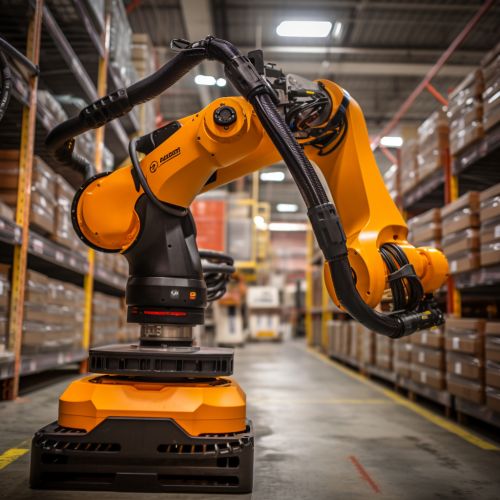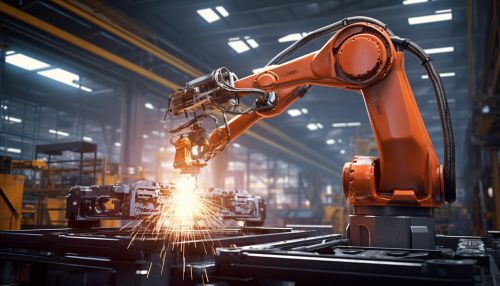Industrial Robotics
Introduction
Industrial robotics is a field of study that focuses on the design, construction, and application of robots in industrial settings. The term "industrial robot" refers to a reprogrammable, multifunctional manipulator designed to move materials, parts, tools, or specialized devices through variable programmed motions for the performance of a variety of tasks. Industrial robots are used in a wide range of industries, including automotive, electronics, medical, food production, and more. The use of industrial robots can lead to increased productivity, improved product quality, reduced waste, and safer working conditions.
History
The history of industrial robotics can be traced back to the early 20th century, when the first concepts of automated machinery were introduced. The first industrial robot, Unimate, was installed in a General Motors plant in 1961. This robot, designed by George Devol and Joseph Engelberger, was used to automate the process of die casting. Since then, the field of industrial robotics has grown exponentially, with advancements in technology leading to more sophisticated and versatile robots.
Types of Industrial Robots
Industrial robots can be categorized into several types based on their mechanical structure, control system, and application. These include:
- Articulated Robots: These robots have rotary joints that allow for a full range of motion. They are the most common type of industrial robot and are used in a variety of applications, including welding, painting, and assembly.
- Cartesian Robots: Also known as gantry or rectilinear robots, these robots move in straight lines along the X, Y, and Z axes. They are typically used in pick and place operations, assembly, and CNC machining.
- SCARA Robots: SCARA stands for Selective Compliance Assembly Robot Arm. These robots are typically used in assembly applications due to their high speed and precision.
- Delta Robots: These robots are designed for high-speed, high-precision work. They are often used in food packaging and electronics assembly.
- Cylindrical Robots: These robots have a cylindrical work envelope and are typically used in assembly operations, handling machine tools, and spot welding.
- Polar Robots: Also known as spherical robots, these robots have a spherical work envelope and are used in handling machine tools, diecasting, fettling machines, gas welding, and arc welding.


Applications
Industrial robots are used in a wide range of applications, including:
- Welding: Robots can perform both spot welding and arc welding. They offer high precision and can work in environments that are dangerous for human workers.
- Material Handling: This includes tasks such as pick and place, palletizing, and packaging. Robots can handle heavy loads and perform repetitive tasks with high accuracy.
- Assembly: Robots can assemble complex components with high precision and speed, reducing the time and cost of production.
- Painting: Robots can apply paint with high precision and consistency, reducing waste and improving product quality.
- Inspection: Robots can perform quality control inspections, using vision systems to detect defects.
- Machining: Robots can perform tasks such as drilling, grinding, and milling.
Advantages and Disadvantages
Like any technology, industrial robots have both advantages and disadvantages.
Advantages include:
- Increased productivity: Robots can work 24/7 without breaks, leading to increased production rates.
- Improved product quality: Robots can perform tasks with high precision and consistency, leading to improved product quality.
- Reduced waste: Robots can use materials more efficiently, reducing waste.
- Safer working conditions: Robots can perform dangerous tasks, reducing the risk of injury to human workers.
Disadvantages include:
- High initial cost: Industrial robots can be expensive to purchase and install.
- Need for skilled workers: Operating and maintaining industrial robots requires skilled workers, which can be a challenge in areas with a shortage of skilled labor.
- Limited capabilities: While robots can perform many tasks, they are not capable of performing tasks that require complex decision-making or creativity.
Future Trends
The field of industrial robotics is constantly evolving, with new technologies and trends shaping the future of the industry. Some of these trends include:
- Increased use of Artificial Intelligence: AI is being used to make robots more intelligent and capable of performing more complex tasks.
- Development of Cobots: Cobots, or collaborative robots, are designed to work alongside human workers, rather than replacing them.
- Increased use of RaaS: RaaS, or Robotics as a Service, is a business model that allows companies to lease robots rather than purchasing them outright.
- Advancements in Robot Vision: Improvements in vision systems are making robots more capable of performing tasks that require visual recognition, such as inspection and sorting.
